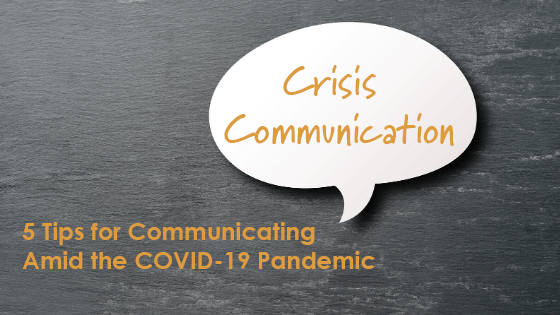
Crisis Communication: 5 Tips for Communicating Amid the COVID-19 Pandemic

As the novel Coronavirus (COVID-19) pandemic sweeps across the world, many businesses and individuals alike are faced with an unprecedented crisis to which they must respond.
Nationwide, business owners and other professionals are focused on how to sustain revenue flow while also working to develop and implement plans for working remotely and communicating details to their consumers.
Right now, it’s difficult to understand the broader implications and complications of the COVID-19 pandemic. However, it’s essential to communicate effectively during this uncertain and challenging time.
Continue reading to learn about 5 tips for communicating amid the COVID-19 global health crisis.
1. Designate a Spokesperson or Small Task Team
It’s unrealistic and inefficient to expect everyone within your business or organization to respond to inquiries, provide updates to customers, etc. about business operations during the COVID-19 outbreak. This is how information and details can be miscommunicated and /or misconstrued.
Instead, consider designating one person or a small group of people from key departments, to be the go-to contact for questions and concerns from consumers. Funneling communication this way will ultimately help ensure that details don’t get lost, accurate information is communicated, and that the messages coming from your business are consistent.
2. Communicate with Employees
The COVID-19 pandemic has sparked incredible panic and fear. Your employees are concerned for their wellbeing, as well as their family members’ health. Further, worry is likely ensuing as it pertains to income and job stability.
Be forthcoming and transparent with them during this time. Communicate with them on a regular basis about ongoing developments and what’s being done internally to handle COVID-19. Take time to point them in the right direction to get facts on the virus (CDC, Department of Health, etc.) and steps they can take to protect themselves.
3. Use Digital Channels to Directly Reach Customers / Clients
It’s important that your customers / clients receive clear, concise updates and notices directly from you. For instance, these updates might include temporary closures, limited hours, transitions to remote work, special offers and promotions, etc.
In today’s modern digital age, people turn to online sources to obtain a majority of their news and information. With this being said, it’s critical that you keep your business’ social media channels current. It’s also a cost-effective (free) way to share information about your business or organization. In addition, be sure to update channels such as Google My Business and Yelp to reflect accurate operating hours and so on.
For a more personal approach, produce and distribute an email / e-blast to your current list of customers. This could be done on an individual basis if possible, or to a group. Provide details about precautions being taken in-house, closures, or changes to hours. Also, include a note about where they can expect to find updates in the future.
4. Communicate to Media
The media is responsible for deploying pertinent news and accurate information to their vast audience base on a daily basis. In times of crisis, this is especially crucial.
It’s imperative to produce a plan for sharing information about your business or organization with the press. Consider drafting and distributing a news release about how your company is operating. For example, restaurant owners may want to share that they are now offering to-go orders and delivery where they didn’t before. Also, be on the lookout for any sort of complimentary resources that local publications might be offering to help. Locally, Florida Weekly and USA Today are helping.
Lastly, depending on your industry and type of business, you may have to prepare to answer media inquiries. This could include questions about precautionary procedures, production capacity, etc.
5. Be Proactive, Not Reactive
With an unknown situation like the one COVID-19 has presented, it can be difficult to determine your next step. Regardless, it’s important to prepare and get ahead as best you can to ultimately maintain control should something go wrong.
Actively brainstorm ideas and options for keeping your business operating, even if it’s at half capacity. Consider alternatives to what you already do. For example, some manufacturing and clothing providers have started making masks during this time, something they’ve never done before. Closely monitor the information shared directly from the CDC, WHO, and your state’s DOH on a daily or hourly basis.
Don’t wait passively by and get caught in a bind. Instead, be ready to act smoothly, quickly, and efficiently if needed.
It’s a very difficult time and you’re not alone in trying to get a handle on the situation. However, effective and consistent communication can help you prepare and ensure that employees, consumers, and media are accurately informed about your business.
For more information on how PTE can help you manage crisis communication during the COVID-19 pandemic, contact us.
You May Like

Image Award Results - PTE Brings Home 3!
We are pleased to announce PTE won 3 awards at the local Florida Public Relations Association’s Image Awards ceremony recently! The firm won a Judges’ Award and Award of Distinction for their work with local nonprofit, Blessings in a Backpack and their Girls Night Out fund-raiser and another Award of

The Importance of Setting Goals - for Career Success
Recently we had the opportunity to attend The Blue Chip Awards Luncheon. A wonderful afternoon filled with successful small business people, great food and inspirational stories, the highlight was key speaker, Nikki Stone. An Olympic gold medalist, Nikki overcame much adversity and physical challenges throughout her career and stressed the

Public Relations Strategy - 10 Steps to Ensure Success
As many of you know, I earned my APR (Accreditation in Public Relations) last year. Quite the process, I learned far more than I thought via studying assigned literature. One such piece, Cutlip & Center's Effective Public Relations 10th edition (EPR 10) was invaluable. Having practiced public relations for large